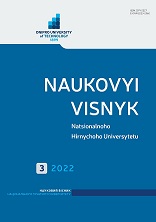

 | Наукова періодика України | 
| Naukovyi visnyk Natsionalnoho Hirnychoho Universytetu |
Slyvna O. V. Graphic pegmatites in the evolution of the Azov block of the Ukrainian shield / O. V. Slyvna // Науковий вісник Національного гірничого університету. - 2015. - № 6. - С. 5-10. - Режим доступу: http://nbuv.gov.ua/UJRN/Nvngu_2015_6_3 Purpose. The study of the material composition of granitoid formations of Western Azov and the establishment of regularities of formation of the pegmatite fields, spatially associated with weakened zones of major geological structures in the Eastern part of the Ukrainian shield. Methodology. The petrographic, mineralogical and termobarogeochemical methods of research were used to solve the main tasks of the research, consisting in the study of petrology and conditions of formation of the pegmatite formations of the area. Findings. Both pegmatites of the Azov block of the Ukrainian shield and enclosing their slates trough structures as well as gneisses and granites are the products of a single metamorphic process typical for the crystalline shields of Precambrian age. They are united by chemical, mineralogical and petrographic composition, structural position, and long period of formation and logical time sequence of formation. To determine the time and place of formation of the fields of pegmatite in the process of formation of the Azov block a study of existing models of the formation of the Ukrainian shield was conducted and compared with the results of the study of micro inclusions of quartz from pegmatites and granites. Pegmatites are formed as a result of a long evolution of mineral-forming process, as evidenced by the presence of typical solid and fluid inclusions of quartz rocks. The established inclusions convey both practical and genetic information. They are the criteria of the dismemberment of granitoid formations of the area and indicate the formation of these rocks by multiple metamorphic and metasomatic changes of source supracrustal strata. The results of our research prove that the geochemical specialization of granites and pegmatites (titanium, aluminum, aluminum-titanium) depends on the composition of the source magmatic rocks, terrigenous formations or their interdigitation with a predominance of one or the other. Subsequent geological processes that led to the formation of the pegmatite fields in Western Azov fit into the classic pattern of development of regional metamorphism. Originality. The geochemical specialization of granites and pegmatites of the Western Azov was established. The revealed regularities of spatial distribution of pegmatite fields close to weakened zones are determined by the minimum manifestations of granitization. We proposed the model of the formation of graphic pegmatites within the Azov block of the Ukrainian shield. Practical value. It was established that the pegmatites of the Azov block were formed on the pneumatic-hydrothermal stage, which was preceded by the processes of accumulation of volcanogenic-sedimentary strata and recrystallization (metamorphism) in gneiss, with subsequent metasomatic transformation in granites and pegmatites. The data obtained can be used to develop the correct scheme for dismemberment of volcanic and plutonic formations for geological survey, forecast-metallogenic and prospecting works. Цитованість авторів публікації: Бібліографічний опис для цитування: Slyvna O. V. Graphic pegmatites in the evolution of the Azov block of the Ukrainian shield / O. V. Slyvna // Науковий вісник Національного гірничого університету. - 2015. - № 6. - С. 5-10. - Режим доступу: http://nbuv.gov.ua/UJRN/Nvngu_2015_6_3. |
|
|
Всі права захищені © Національна бібліотека України імені В. І. Вернадського |
|||||